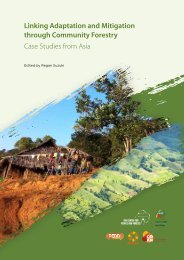Desktop Study on - Regional Climate Change Adaptation ...
Desktop Study on - Regional Climate Change Adaptation ...
Desktop Study on - Regional Climate Change Adaptation ...
Create successful ePaper yourself
Turn your PDF publications into a flip-book with our unique Google optimized e-Paper software.
<str<strong>on</strong>g>Desktop</str<strong>on</strong>g> <str<strong>on</strong>g>Study</str<strong>on</strong>g><br />
RESEARCH SYNTHESIS ON CAMBODIA<br />
The country characteristics cover informati<strong>on</strong><br />
<strong>on</strong> Cambodia’s geographical, social, ec<strong>on</strong>omic<br />
and climatic risks. An overview of the country’s<br />
characteristics is provided in Table 12.<br />
Geographic Situati<strong>on</strong><br />
Cambodia extends an area of 181,035 sq km,<br />
bordering three countries, namely, Thailand, Lao<br />
PDR and Viet Nam, in the east to west parts (Royal<br />
Government of Cambodia, 2009). Of its total land<br />
area, 53 percent is covered by forest and 21 percent<br />
is cultivated. The regi<strong>on</strong>s surrounding the Mek<strong>on</strong>g<br />
River and the Tônlé Sap Lake are most fertile.<br />
The Mek<strong>on</strong>g River, the l<strong>on</strong>gest river in Southeast<br />
Asia and the tenth largest in the world, flows into<br />
Cambodia from the northern border with Lao PDR<br />
and runs out through the southern border with Viet<br />
Figure 35: Locati<strong>on</strong> map of Cambodia<br />
(CIA, 2009)<br />
Nam. The Tônlé Sap, the country’s principal lake<br />
and the largest in Southeast Asia, drains into the<br />
Mek<strong>on</strong>g River at Phnom Penh. Every year during the<br />
m<strong>on</strong>so<strong>on</strong> seas<strong>on</strong> approximately between May and<br />
October, the amount of water of the Mek<strong>on</strong>g River<br />
increases and the river flow reverses and drain into<br />
the lake. The lake then expands its size dramatically,<br />
flooding the provinces al<strong>on</strong>g its banks. When the<br />
dry weather returns, the river reverses its flow back<br />
again, draining into the Mek<strong>on</strong>g. At the time of the<br />
flooding, the Tônlé Sap reaches about four times its<br />
size in the dry seas<strong>on</strong>. Despite this fluctuati<strong>on</strong> of the<br />
Figure 36: <strong>Climate</strong> hazard map of the<br />
Cambodia (Extracted from<br />
Multiple climate hazard map<br />
of Southeast Asia, Yusuf A.A.<br />
and H.A. Francisco, 2009))<br />
Lao PDR •<br />
Thailand •<br />
• Viet Nam<br />
Cambodia •<br />
106

















